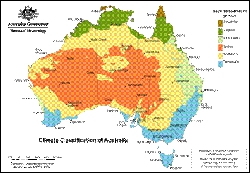|
|
Climatic processesClimate is the long term pattern of weather cycles in a particular area[2]. Climate influences temperature, evaporation, humidity, and the amount and seasonality of rainfall. These factors are critical drivers for wetlands as they play a significant role in determining water quantity and wetting regime, which, in turn, affect virtually all other aspects of wetland ecosystems e.g. water quality, connections to other wetlands, nutrient cycling and animal breeding and movement. Information on this topic is available at the following web page: Climate can be classified into zones using criteria such as rainfall, temperature, humidity, and vegetation. The Climate Classification of Australia from the Bureau of Meteorology website is recommended as the base map for this layer. RainfallPrecipitation results in lateral run-off from the surrounding land into wetlands supplying nutrients and debris (allochthonous inputs) to the system. In a number of areas rainfall is the main source of water for wetlands. However, it is commonly exceeded by the evaporation rate. In cases where flow is inextricably tied to rainfall, the occurrence and timing of wet/dry seasons may have important implications for the ecology of the flora and fauna of the region. ExamplesSome frog species require precipitation rather than floodplain inundation to spawn. Such species have a limited window of opportunity to spawn in this province, but as long as spawning and the subsequent recruitment of juveniles are successful, the species may persist. Thus many species of frogs within dry provinces are 'burrowing frogs' which dig into floodplain mud when it is soft and enter a state of drastically reduced metabolism for long periods until rainfall re-wets the mud[4]. They then emerge from the mud and reproduce rapidly while conditions are favourable. Tadpole development is influenced by temperature and is accelerated with higher temperatures allowing tadpoles to become adults before the spawning sites dry out. The adult frogs have morphological adaptations for burrowing, such as metatarsal tubercles for scraping soil, and they generally have a broad head, bulbous body and short limbs.[4] References
Last updated: 22 March 2013 This page should be cited as: Department of Environment, Science and Innovation, Queensland (2013) Climatic processes, WetlandInfo website, accessed 18 March 2024. Available at: https://wetlandinfo.des.qld.gov.au/wetlands/ecology/processes-systems/climate/ |

 — Department of Environment, Science and Innovation
— Department of Environment, Science and Innovation


